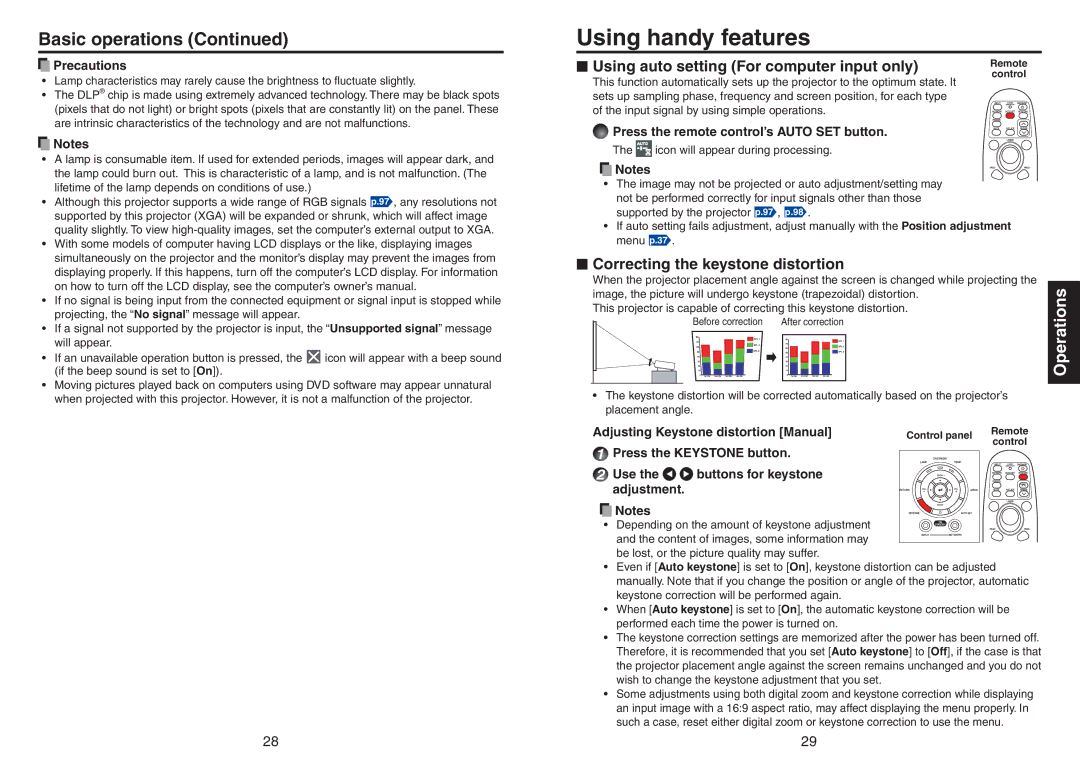
Basic operations (Continued)
 Precautions
Precautions
•Lamp characteristics may rarely cause the brightness to fluctuate slightly.
•The DLP® chip is made using extremely advanced technology. There may be black spots (pixels that do not light) or bright spots (pixels that are constantly lit) on the panel. These are intrinsic characteristics of the technology and are not malfunctions.
![]() Notes
Notes
•A lamp is consumable item. If used for extended periods, images will appear dark, and the lamp could burn out. This is characteristic of a lamp, and is not malfunction. (The lifetime of the lamp depends on conditions of use.)
•Although this projector supports a wide range of RGB signals p.97 , any resolutions not supported by this projector (XGA) will be expanded or shrunk, which will affect image quality slightly. To view
•With some models of computer having LCD displays or the like, displaying images simultaneously on the projector and the monitor’s display may prevent the images from displaying properly. If this happens, turn off the computer’s LCD display. For information on how to turn off the LCD display, see the computer’s owner’s manual.
•If no signal is being input from the connected equipment or signal input is stopped while projecting, the “No signal” message will appear.
•If a signal not supported by the projector is input, the “Unsupported signal” message will appear.
•If an unavailable operation button is pressed, the ![]() icon will appear with a beep sound (if the beep sound is set to [On]).
icon will appear with a beep sound (if the beep sound is set to [On]).
•Moving pictures played back on computers using DVD software may appear unnatural when projected with this projector. However, it is not a malfunction of the projector.
Using handy features
■ Using auto setting (For computer input only) | Remote |
| control |
This function automatically sets up the projector to the optimum state. It sets up sampling phase, frequency and screen position, for each type of the input signal by using simple operations.
 Press the remote control’s AUTO SET button.
Press the remote control’s AUTO SET button.
The ![]()
![]()
![]() icon will appear during processing.
icon will appear during processing.
![]() Notes
Notes
•The image may not be projected or auto adjustment/setting may not be performed correctly for input signals other than those supported by the projector p.97 , p.98 .
•If auto setting fails adjustment, adjust manually with the Position adjustment menu p.37 .
■Correcting the keystone distortion
When the projector placement angle against the screen is changed while projecting the image, the picture will undergo keystone (trapezoidal) distortion.
This projector is capable of correcting this keystone distortion.
Before correction | After correction | ||||||||||||
|
|
|
|
|
|
|
|
|
|
|
|
|
|
|
|
|
|
|
|
|
|
|
|
|
|
|
|
|
|
|
|
|
|
|
|
|
|
|
|
|
|
|
|
|
|
|
|
|
|
|
|
|
|
|
|
|
|
|
|
|
|
|
|
|
|
|
|
|
|
|
|
|
|
|
|
|
|
|
|
|
|
|
|
|
|
|
|
|
|
|
|
|
|
|
|
|
|
|
|
|
|
|
|
|
|
|
|
|
|
|
|
•The keystone distortion will be corrected automatically based on the projector’s placement angle.
Adjusting Keystone distortion [Manual] | Control panel | Remote | |
1 Press the KEYSTONE button. |
| control | |
|
| ||
2 Use the | buttons for keystone |
|
|
adjustment. |
|
|
|
![]() Notes
Notes
• Depending on the amount of keystone adjustment and the content of images, some information may be lost, or the picture quality may suffer.
•Even if [Auto keystone] is set to [On], keystone distortion can be adjusted manually. Note that if you change the position or angle of the projector, automatic keystone correction will be performed again.
•When [Auto keystone] is set to [On], the automatic keystone correction will be performed each time the power is turned on.
•The keystone correction settings are memorized after the power has been turned off. Therefore, it is recommended that you set [Auto keystone] to [Off], if the case is that the projector placement angle against the screen remains unchanged and you do not wish to change the keystone adjustment that you set.
•Some adjustments using both digital zoom and keystone correction while displaying an input image with a 16:9 aspect ratio, may affect displaying the menu properly. In such a case, reset either digital zoom or keystone correction to use the menu.
Operations
28 | 29 |
